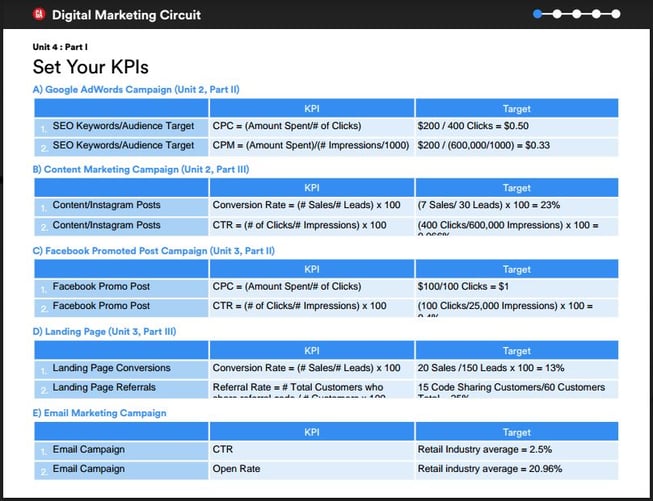This is week four of Changing Course to a Career in Marketing: "Math on Purpose" by Guest Blogger and Artisan Talent Sarah Antao. Get up to date with her first post here, second, and last week's post here...then read on to learn about doing math on purpose!
If you ask any number of friends or teachers from high school what my feelings are on math, you would probably hear them say something along the lines of “Yikes,” “Woof,” or “It’s a good thing she can read.”
To me, anyone who is remotely competent with a calculator is basically a wizard.
 (Me watching anyone solve a math problem)
(Me watching anyone solve a math problem)
That said, I was surprised by how much I connected to this part of the Digital Marketing Circuit. This week’s topic was Metrics and Key Performance Indicators (KPIs), marking the last piece of the Circuit puzzle before combining all of the units into a final project.
A little digital marketing vocab lesson
Metrics: Results obtained through measurement
KPIs: Metrics a business picks to determine how well its strategy is working
The goal of Unit 4 was to move past what tactics I planned to use to meet my objectives and dive into how and if these tactics would be cost effective and successful.
Digital Marketing Metric Takeaways
1. Make sure your objectives are clear
In the first few units, General Assembly emphasizes the importance of SMART objectives. These are campaign goals that are specific and measurable.
For example, my objective was to bump awareness and acquisition for the Three Peaks Wax Co. site by 25% over 4 weeks.
2. There are A LOT of metrics covered in the unit. Try to keep your project in mind.
The course material covers a lot of hypothetical situations and gives you an opportunity to analyze KPIs for Google and Facebook ads. Some KPIs may apply to your project, others might focus on different stages of a marketing strategy.
The best plan is to flag KPIs, as you go, that echo your objective.
In my case, Three Peaks Wax Co. is a new brand looking to expand their reach and customer base, so I needed KPIs that would measure how many people would see and engage with an ad, including:
- Cost per Click (CPC)
- Click Through Rate (CTR)
- Cost “Per Mille” aka Cost per Impression x 1000 (CPM)
3. The homework is a lot simpler than it looks
Overall, the course designers did a great job of breaking each metric down with easy-to-follow slides and detailed visual aids, but I did stumble a little in the assessment portion of Unit 4. The key here is to take advantage of the references that General Assembly gives you, because they are essentially cheat sheets.
Like I mentioned last week, having a real-life model to base your project on (like working with Three Peaks Wax Co.) is incredibly helpful. This way, you can draw actual numbers to determine a campaign budget which can give you a more realistic analysis of your KPIs.
Here's an example page from the final version of my Unit 4 project:

Four pages of algebra later, I submitted my project and held my breath — and by some miracle, I aced it!
Sure, I probably won’t wander into a classroom at MIT and solve a giant equation on a chalkboard… but I give a lot of credit to the way General Assembly breaks down this unit, in particular.
It might be a little more tedious but the scientific side of Digital Marketing feels more accessible to me now than it ever has before and that’s a big deal.
That’s it for this week, folks! Come back next week to hear how my final project went and my feelings on my five weeks with GA!
 Sarah Antao is a freelance Editor and Writer from Rochester, NY (Home of Kodak and Taye Diggs). She enjoys writing and performing with her sketch group, Supper Club and listening to true crime podcasts. Apart from a career in marketing, Sarah considers her other dream job to be one of the judges on a tv cooking competition. She can be found on instagram and @supperclubchicago on Facebook.
Sarah Antao is a freelance Editor and Writer from Rochester, NY (Home of Kodak and Taye Diggs). She enjoys writing and performing with her sketch group, Supper Club and listening to true crime podcasts. Apart from a career in marketing, Sarah considers her other dream job to be one of the judges on a tv cooking competition. She can be found on instagram and @supperclubchicago on Facebook.





